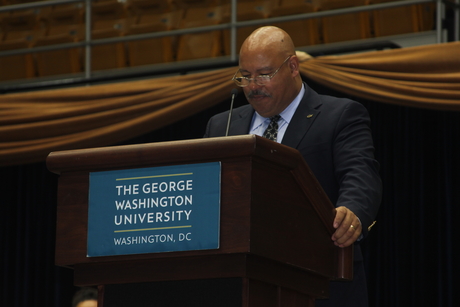By Michael Tapscott
The Multicultural Student Services Center (MSSC) Graduation Celebration was inspired by a dialogue between MSSC staff and a group of African-American seniors in the spring of 2007. The more we talked, the more we realized the potential impact and unique opportunity we were considering. The MSSC staff was looking for an opportunity to build unity within the black student and some seniors wanted a meaningful vehicle for expressing their satisfaction with their GW experience, so the celebration seemed to be a win-win. Andrea Williford became our primary committee partner as we talked through the vision, mission, and impact of the event. It was important to ground the event in a philosophy that was inclusive, open, and added value to the student experience.
Today the concept of a graduation celebration, among those of us who work in multicultural student centers, is not uncommon, although it has been and continues to be a topic of debate among cultural center, academic, and student life leaders.
One of my goals as director of the MSSC is to encourage students to maintain a strong lifelong connection to GW, and to the MSSC. My vision for the graduation celebration was to leave students with one long, lasting, joyful, memory as the capstone to this stage of their GW experience. We wanted an experience that surrounds them with friends, classmates, faculty, staff, and parents as well. We wanted an experience that shouted out to the students in a very public manner; that “you matter, you are important, and we are thankful that you are a part of this GW family, forever.”
Only forty years before the development of the graduation celebration, more than 200 of our black and white students were protesting in front of Rice Hall over the treatment of African-American students on campus and black culture in the curriculum. This was fourteen years after the Brown v. Board of Education decision and four years after the Civil Rights Act of 1964. Today, we use the graduation celebration as one of many indicators of GW’s advancement since that time.
When the university administration sanctioned the event, it sent a clear, powerful, and very public message to the GW community that all of our communities are important, and have value. More importantly, the message was that we are willing to be creative and nudge people towards conversations about diversity, even if they are a little uncomfortable. Since the initial implementation of the program in 2008, we have found creative ways to invite, encourage, and welcome the broadest range of the diversity in the GW community to participate, because everyone is diverse in some way.
One of the big heroes of this event was Jason Wilson, the Assistant Athletics Director for Facilities at the time. His support and advocacy helped to secure the Charles E. Smith Center, which has served as the home for this program since 2008. Wilson assisted us in securing the Smith Center and provided technical guidance to ensure we executed a first-rate event. Maybe more importantly, he was a true believer in the celebration’s potential to persuade these the graduates to see themselves as lifelong Colonials.
In terms of structure and planning, MSSC staff and students look at best practices in the area, and among peer institutions. Everything that we do is designed to strengthen the relationship between each individual student and the institution we all love. We recognize each student’s academic, student life, and leadership accomplishments, and affirm their value and contribution to the GW community.
We are excited to have a program that highlights one of the most important periods in our students’ lives. Graduation is one of the most critical milestones in a young person’s life; we want to make it as meaningful, satisfying, and heartwarming as possible.


